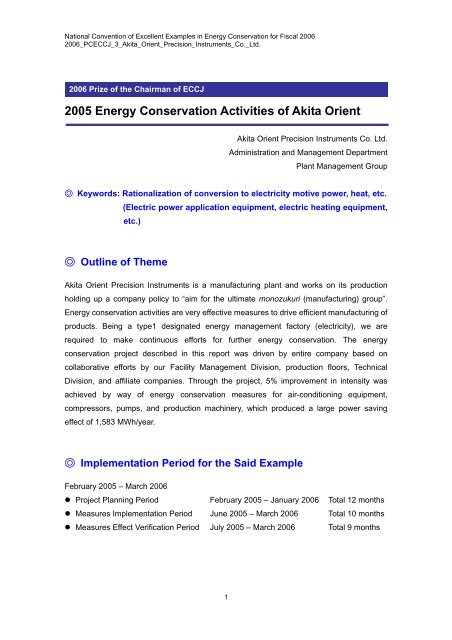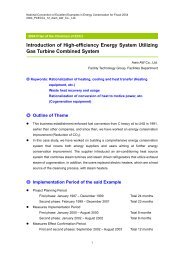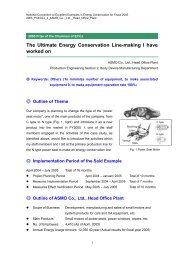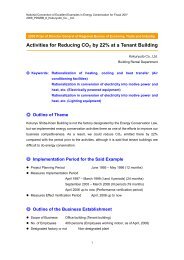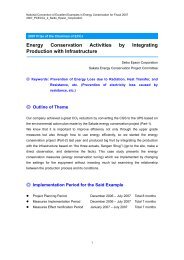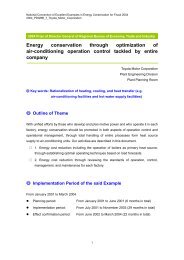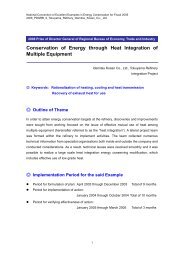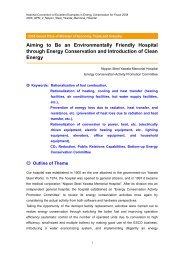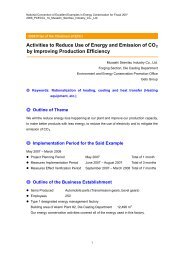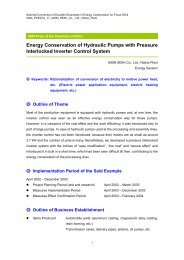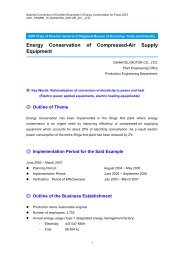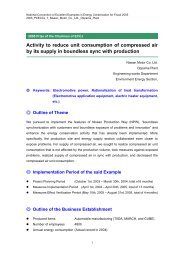Akita Orient Precision Instruments Co. Ltd. - ECCJ
Akita Orient Precision Instruments Co. Ltd. - ECCJ
Akita Orient Precision Instruments Co. Ltd. - ECCJ
Create successful ePaper yourself
Turn your PDF publications into a flip-book with our unique Google optimized e-Paper software.
National <strong>Co</strong>nvention of Excellent Examples in Energy <strong>Co</strong>nservation for Fiscal 20062006_PC<strong>ECCJ</strong>_3_<strong>Akita</strong>_<strong>Orient</strong>_<strong>Precision</strong>_<strong>Instruments</strong>_<strong>Co</strong>._<strong>Ltd</strong>.2006 Prize of the Chairman of <strong>ECCJ</strong>2005 Energy <strong>Co</strong>nservation Activities of <strong>Akita</strong> <strong>Orient</strong><strong>Akita</strong> <strong>Orient</strong> <strong>Precision</strong> <strong>Instruments</strong> <strong>Co</strong>. <strong>Ltd</strong>.Administration and Management DepartmentPlant Management Group◎ Keywords: Rationalization of conversion to electricity motive power, heat, etc.(Electric power application equipment, electric heating equipment,etc.)◎ Outline of Theme<strong>Akita</strong> <strong>Orient</strong> <strong>Precision</strong> <strong>Instruments</strong> is a manufacturing plant and works on its productionholding up a company policy to “aim for the ultimate monozukuri (manufacturing) group”.Energy conservation activities are very effective measures to drive efficient manufacturing ofproducts. Being a type1 designated energy management factory (electricity), we arerequired to make continuous efforts for further energy conservation. The energyconservation project described in this report was driven by entire company based oncollaborative efforts by our Facility Management Division, production floors, TechnicalDivision, and affiliate companies. Through the project, 5% improvement in intensity wasachieved by way of energy conservation measures for air-conditioning equipment,compressors, pumps, and production machinery, which produced a large power savingeffect of 1,583 MWh/year.◎ Implementation Period for the Said ExampleFebruary 2005 – March 2006• Project Planning Period February 2005 – January 2006 Total 12 months• Measures Implementation Period June 2005 – March 2006 Total 10 months• Measures Effect Verification Period July 2005 – March 2006 Total 9 months1
National <strong>Co</strong>nvention of Excellent Examples in Energy <strong>Co</strong>nservation for Fiscal 20062006_PC<strong>ECCJ</strong>_3_<strong>Akita</strong>_<strong>Orient</strong>_<strong>Precision</strong>_<strong>Instruments</strong>_<strong>Co</strong>._<strong>Ltd</strong>.◎ Outline of the Business Establishment• Items Produced Manufacturing of printer heads and quartz crystals• No. of Employees 928 (as of April 1, 2006)• Annual Energy Usage Amount (Actual results for fiscal year 2005)Type A heavy oil 316 kLKerosene408 kLElectricity19,348 MWh◎ Process Flow of Target FacilityAir-conditioning(Heat Source Equipment, Pumps,and Air-conditioning Units)ProductionMachineryProductsElectricity <strong>Co</strong>mpressors Vacuum PumpsFig. 1 Process Flow1. Reasons for Theme SelectionBeing a manufacturing plant, <strong>Akita</strong> <strong>Orient</strong> must contribute to society and make profits by“monozukuri” as well as be an energy-conserving and environmentally conscious plant.Recently, companies are required to perform their business activities satisfying the bothaspects. Since overseas productions have become a mainstream in manufacturing industryin recent years, we have been working on our manufacturing business aiming for becoming“the ultimate monozukuri group” in order to survive the “intensified cost competitions” as adomestic manufacturing base. Energy conservation activities are effective for the corporateactivities to achieve the goal, in terms of possible cost reductions through effectivemanufacturing of products using less energy.After being designated as a type1 designated energy management factory (electricity) in1999, the plant has continued its energy conservation activities based on the efforts towardmaking “a large effect using our wisdom and innovative ideas without spending muchmoney”. Due to additional installation of production machinery, it was expected that the2
National <strong>Co</strong>nvention of Excellent Examples in Energy <strong>Co</strong>nservation for Fiscal 20062006_PC<strong>ECCJ</strong>_3_<strong>Akita</strong>_<strong>Orient</strong>_<strong>Precision</strong>_<strong>Instruments</strong>_<strong>Co</strong>._<strong>Ltd</strong>.plant’s electric consumption would be increased in FY2005, leading to “worse intensity”.<strong>Co</strong>nsidering the above, we reached a decision that “further enhanced activities tackled bythe entire company as a team” through “collaboration by various divisions” is rather requiredthan previous activities which were mainly led by each division. We determined to develop anew structure to implement the activities.2. Understanding and Analysis of Current Situation(1) Understanding of Current SituationIn order to understanding current situation, it is necessary to make measurement andrecords as described in “Evaluation Criteria of the Law concerning the Rational Use ofEnergy (Energy <strong>Co</strong>nservation Law)”. When the company received an on-site inspection byBureau of Economy, Trade and Industry in 2004, information for electric consumption byindividual equipment needed for preparing a summary report and micro data was foundunclear, and that made us recognize a strong need for measuring equipment. Since“understanding of current situation” was necessary as a first step of our new energyconservation activities, a “power monitoring system” was installed following the inspectionand it was connected to our internal LAN with a real-time access to current powerconsumptions. The “visualization” established by the new system made it possible for us toview current electric consumption and effects achieved by placing improvement measures.(2) Analysis of Current SituationFig. 2 shows a breakdown of electric consumption in FY2004.Electricity consumed by compressors accounts for 22%, the largest proportion as singleequipment. Basic facilities account for 44%, of which 38% is for air-conditioning equipmentincluding air-conditioning units, chilled/hot water generator, and pumps. The next 28% isconsumed by production machinery which includes various types of machines andequipment, which require individual measures. Electric lights such as ceiling lamps and deskequipment account for 6%.3
National <strong>Co</strong>nvention of Excellent Examples in Energy <strong>Co</strong>nservation for Fiscal 20062006_PC<strong>ECCJ</strong>_3_<strong>Akita</strong>_<strong>Orient</strong>_<strong>Precision</strong>_<strong>Instruments</strong>_<strong>Co</strong>._<strong>Ltd</strong>.Electric Lights<strong>Co</strong>mpressorsProductionMachinery(Air-conditioning:38%)Basic Facilities3. Progress of Activities(1) Implementation StructureFig. 2 Breakdown of Electric <strong>Co</strong>nsumption in FY2004The previous structure for promoting energy-conservation activities was vertically dividedinto business divisions focusing on divisional activities, and resulted in poor communicationand cooperation among the divisions. Since “further enhanced activities are needed” for thenew program, a structure with close connections among the divisions was developed thistime. Persons in charge of project were selected from each division and they were in chargeof compressor system (compressed air system), basic facilities, and production machineryto establish a driving structure through “collaboration by various divisions”. A secretariat(Facility Management Division) was engaged in to supplement the approach.President and CEOEnergy-<strong>Co</strong>nservationPromotion <strong>Co</strong>mmitteeEnergy ManagerProductionFloorsEngineeringDivisionFacility Management Division (Secretariat)<strong>Co</strong>mpressed AirSystem GroupBasic FacilitiesGProductionMachinery GroupAffiliate<strong>Co</strong>mpaniesFig. 3 Program Structure Chart(2) Target SettingsWe sets out an environmental objective/target of ISO1401 by 7% reduction compared toprevious year by CO 2 equivalent and to achieve the target a total CO 2 reduction of 831(t-CO 2 ) is required. We developed and implemented measures for this achievement.4
National <strong>Co</strong>nvention of Excellent Examples in Energy <strong>Co</strong>nservation for Fiscal 20062006_PC<strong>ECCJ</strong>_3_<strong>Akita</strong>_<strong>Orient</strong>_<strong>Precision</strong>_<strong>Instruments</strong>_<strong>Co</strong>._<strong>Ltd</strong>.(3) Problem Points and Their InvestigationIn order to meet the very challenging target, “development of cooperative framework toobtain cooperation by each division” was required. Since we must improve product qualityand productivity as a manufacturing plant, we determined to work on expanding theactivities to production floors, which had been unwilling to accept such measures due tosome concerns over “impact on product quality”, as “activities driven by collaboration byvarious divisions”. Having “promotion of energy conservation activities while maintainingand even improving product quality” as a keyword, we drove the project forward.Since many ideas were needed for the measures, we started seeking what could betargeted for the energy conservation project by reviewing general energy conservationcases and through affiliate companies’ efforts in looking around shop floors. We visited tosee the floors and put ideas out for the energy saving measures, based on the sangen shugi,or “ the three actual philosophy”, which means you need to go to actual site, observe actualpart/product, and face the actual situation to understand what is going on. We also asked allemployees for 1,000 ideas to be submitted as an activity in the “Energy-conserving IdeasMonth” which we had developed as a part of the company’s proposal system forimprovement. The approach created an opportunity for every employee to think aboutenergy conservation and raise his/her awareness on the topic.[1] <strong>Co</strong>mpressor systemOur analysis on current situation found that 22% of total electricity was consumed by thecompressor system, making up the largest proportion as single equipment. The compressorsystem of the plant consists of 13 oil-free compressors; two 22 kW units, eight 55 kW units,and three 100 kW units. Since all but the 100 kW units are single-stage compressors whichare less efficient than two-stage compressors, only the necessary number of units isoperated under the control by an Operating Units <strong>Co</strong>ntrol System. Electric consumptionrequired by an unloading operation of a 55 kW compressor is 26 kW and, according to themeasured and recorded data, the unloading time was found to be very long, reachingannual power consumption to 187k kWh. Taking account of the findings, we determined tofocus on “reduction of the unloading time”. Since it was proven by previous case study thatinstallation of an efficient compressor would be effective for energy saving, cost for installinga new highly-efficient compressor was prepared in budget.5
National <strong>Co</strong>nvention of Excellent Examples in Energy <strong>Co</strong>nservation for Fiscal 20062006_PC<strong>ECCJ</strong>_3_<strong>Akita</strong>_<strong>Orient</strong>_<strong>Precision</strong>_<strong>Instruments</strong>_<strong>Co</strong>._<strong>Ltd</strong>.[2] Basic facilitiesSeveral measures, including a proposal based on the findings through affiliate companies’efforts in looking around shop floors and a draft measure for enhancing control ofair-conditioning units, were reviewed to narrow down to several themes for measures to betaken by the collaboration of various divisions.1) Energy conservation of vacuum pumpsRegarding the two units of water-seal 22 kW vacuum pumps constantly operated, we madean investigation on a necessary degree of vacuum and made some experiments, trying tosee if we could make the operation by only 1 unit.2) Energy conservation of chilled/hot water pumpsIt was found through the affiliate companies’ efforts in looking around the floors that openingof the valves of chilled/hot water pumps for air-conditioning heat source was fixed to 30%,resulting in inefficient operations. We found that this was the process where we could gainlarge energy-saving effect by placing appropriate measures. (The air-conditioning systemwas using a chilled/hot water generator as its heat source and chilled/hot water pumps tocirculate the water in constant flow rate.)3) Energy conservation of air-conditioningSince the plant takes a shift work system, air-conditioning for 24 hours a day is required,resulting in large consumption of electricity. We were considering how we could improve theelectricity consumption.Although there were temperature and humidity control values as quality requirements to beobserved by shop floors workers, actual conditions were not clear and it was difficult to placeany measures in the area. <strong>Co</strong>nsidering the above, we developed a plan to firstly select asample shop floor to carry out activities for energy conservation of the air-conditioningsystem through collaboration by various divisions, and then extend the measures to otherfloors [3] Production machinerySince there were various types of production machinery, we worked on investigating theshop floors based on the sangen shugi, understanding the current situation, exchangingideas, and making discussions on investment recovery effect. As we look around the floors(looking for what could be targeted in the energy saving project), we saw some machineswith their power on while they were not producing any products. Following measurement of6
National <strong>Co</strong>nvention of Excellent Examples in Energy <strong>Co</strong>nservation for Fiscal 20062006_PC<strong>ECCJ</strong>_3_<strong>Akita</strong>_<strong>Orient</strong>_<strong>Precision</strong>_<strong>Instruments</strong>_<strong>Co</strong>._<strong>Ltd</strong>.electricity consumption by such machines, it was confirmed that “the machines not runningfor production use sand-by power equals to 70% of the power consumed by running time”.As we examined if we could reduce the stand-by power, we learned that there would beseveral problems when we put the power off the machines (complete shutoff of a breaker ofthe machines).4. Details of Measures[1] <strong>Co</strong>mpressor systemIn the past, we implemented several measures, including installation of an Operating Units<strong>Co</strong>ntrol System and highly-efficient compressor, check and repair of air-leakage, lowereddew-point temperature, lowered supply pressure, enlarged pip diameter and looped thepiping system, review of compressor layout, and additional installation of air tanks, etc. Thisreport describes the details of our continuous approach mentioned above.1) Reduction of unloading timeLoading, unloading, and shutdown were controlled by the Operating Units <strong>Co</strong>ntrol System.Through our study based on sangen shugi trying to understand current situation of themachine operations, it was found that unnecessary unloading operations were madebecause the control system had poor traceability to load changes. Further a long time isused when the machine stops the operation after the unloading operation.Since detailed setting of the Operating Units <strong>Co</strong>ntrol System was as it was when themachine had been installed, we checked its setting to see if it was appropriate. Then, it wasconfirmed that “the unloading time could be shortened by modifying the initial setting”. To bemore precise, we found a couple issues concerning the setting as shown below:a) Due to poor traceability to load changes, the 2nd unit starts running soon after load upbecause the system still thinks only the 1st unit cannot cover required load. Therefore,we made an adjustment on the latency effects for the starting time of the 2nd unit.b) Based on specifications of the compressor, certain period of time not allowing a shutdownoperation (cooling time) is set. The setting makes the system keep running for at least 20minutes once it starts operating, regardless of loading or unloading operations.Furthermore, an “unloading operation time” until the system shuts down after unloading isordered was also set. By adjusting the default time setting, the unloading time wassuccessfully reduced.7
National <strong>Co</strong>nvention of Excellent Examples in Energy <strong>Co</strong>nservation for Fiscal 20062006_PC<strong>ECCJ</strong>_3_<strong>Akita</strong>_<strong>Orient</strong>_<strong>Precision</strong>_<strong>Instruments</strong>_<strong>Co</strong>._<strong>Ltd</strong>.2) Installing additional highly-efficient compressorSince it was proven by previous case study that installation of a highly-efficient compressorwas effective, 1 unit of such compressor was additionally installed. We changed theoperational structure to have the new efficient compressor constantly operated as a mainunit, supplemented by operation of certain number of single-stage compressors whenadditional load requires them. An inverter-controlled freezing dryer was installed for an airdrying purpose.[2] Basic facilitiesThe measures we have implemented include: displaying a manager of air-conditioning unitsand clarifying their settings (display); scheduled operation of air-conditioning units; installingan ice storage unit; enhancing thermal insulation by spraying urethane material; installingdouble sash windows; applying (heat insulating) film on windows; installing window shades;setting light thinning and attaching individual switches to lights; turning off lights during lunchbreak; using Hf lights, sensor-controlled lights, timer-controlled lights, and dummy lighttubes; installing photovoltaic unit; miniaturization and inverter of pumps; installing highlyefficient motors; and adding a capacitor for power factor improvement.1) Energy conservation of vacuum pumpThe two water-seal 22 kW vacuum pumps currently operated. As we investigated andunderstand current situation of production floors, we learned that high degree of vacuumwas required by a small number of production machinery. Taking the fact into consideration,we determined to attach a small vacuum pump (in-stock item) to the production machineryso that operation of one water-seal pump on the supply side could be stopped. Based on theexperimental operations which were found successful, we completed the improvement insuspending one of the 22 kW vacuum pumps.2) Energy conservation of chilled/hot water pumpsThe opening of the valves of chilled/hot water pumps used for air-conditioning heat sourcewas set to nearly 30%, leading to inefficient operations. In order to solve the issue, somemeasures such as installation of smaller pumps and cutting impellers were proposed,however, a shift to inverter control was determined to be the best way to meet ourrequirement for controlling the flow to minimized level and making it adjustable dependingon load changes.8
National <strong>Co</strong>nvention of Excellent Examples in Energy <strong>Co</strong>nservation for Fiscal 20062006_PC<strong>ECCJ</strong>_3_<strong>Akita</strong>_<strong>Orient</strong>_<strong>Precision</strong>_<strong>Instruments</strong>_<strong>Co</strong>._<strong>Ltd</strong>.3) Energy conservation of air-conditioningWe made an investigation to understand current situation based on the sangen shugi.Through installing a temperature/humidity data logger to the sample shop floor tounderstand current conditions in comparison with required temperature/humidity controlvalues, and to check and validate their variations. (The air-conditioning system was runningthrough air-handling units to control overall air-conditioning and 5 backup units tosupplement additionally required loads.) As a result of the investigation, it was found thattemperature near windows was higher due to “sun light through the windows” and tomitigate the temperature rise, some window shades were attached. It was also found thatthere were some areas which were cooled excessively. Focusing on the fact thatair-conditioning units for backup were constantly operated, we carried out someexperiments for verifying that there was no relationship between temperature and productquality, and therefore, the backup units could be stopped. Since operation of the backupunits was controlled by a manually adjustable dial in 1 to 5 levels, the original sensor wasdetached and replaced with an external sensor which could accept temperature setting inorder to make proper temperature control. Operation and air blowing of the air-conditioningunits were controlled by their sensor and the fans were also constantly running.Taking account of the above facts, we placed measures to improve the control system sothat fans would stop running while the air-conditioning units themselves were not inoperation.[3] Production machineryIn order to reduce stand-by power of the machines not running for production, we formed anew working group involving some persons with expertise. Starting with identifying problems,we learned some reasons why “the machine power cannot be turned off”, such as loss ofprogram, a long time required for restarting the machines, and difficulties to secure productquality after restarting. As we worked on understanding the current situation, analysis, andverification, we found the fact that backup batteries for maintaining the program memorywere not regularly replaced with new ones. The bad practice caused some machines to losetheir data when it stops the operation and not to recover it after restarting. To solve theproblem, we replaced batteries of 144 relevant machines, made experimental “power-off”operations, and confirmed that their “restarting time” and “quality after restarting the system”were both good enough. (Regular replacement of backup batteries was incorporated intostandard procedures). After that, a new operational structure was established to implement9
National <strong>Co</strong>nvention of Excellent Examples in Energy <strong>Co</strong>nservation for Fiscal 20062006_PC<strong>ECCJ</strong>_3_<strong>Akita</strong>_<strong>Orient</strong>_<strong>Precision</strong>_<strong>Instruments</strong>_<strong>Co</strong>._<strong>Ltd</strong>.a rule to “power off production machinery while they are not running for production”, whichresulted in successful reduction of the stand-by power.5. Effects after Implementing Measures[1] <strong>Co</strong>mpressor system1) Reduction of unloading timeBy changing the setting of “unloading operation time” between starting time of unloadingordered on the Operating Units <strong>Co</strong>ntrol System and actual shutdown time of the compressor,the unloading time of the compressor unit was successfully reduced. <strong>Co</strong>mpared to averageunloading rate of 34% in FY2004, the rate after implementing the improvement measureswas 14%, improved by 20%. Operation time was also reduced through our reviews on thetraceability of the control system.• Annual power reduction: considerable reduction amount 155,000 kWh/year (only throughchanges in machine setting, with no investment cost)(conversion to operation time in FY2005)2) Installing additional highly-efficient compressorSince one unit of two-stage 100 kW compressor is capable of supplying the amount of airwhich would require 2.7 units of single-stage 55 kW compressors, the installation of thetwo-stage compressor generated reduction effect for 51 kW. The installed inverter-controlledfreezing air-dryer, making it possible to control rotation speed depending on loading level,generated additional 2.5 kW reduction compared to conventional type. After all, thecompressor intensity was successfully reduced (Table 1).• Annual power reduction: considerable reduction amount 461,000 kWh/year (investmentrecovery 2.5 years)Table 1 Changes in <strong>Co</strong>mpressor Intensity (kWh/m 3 )FY1999 FY2002 FY2005<strong>Co</strong>mpressor Intensity 0.1708 0.1403 0.1149Difference - Improvement by22%Improvement by 22%[2] Basic facilities1) Energy conservation of vacuum pumpWe succeeded in reducing number of operating water-seal 22 kW vacuum pumps to oneunit, stop the operation of other one. Two units of 1.5 kW cooling water pumps and cooling10
National <strong>Co</strong>nvention of Excellent Examples in Energy <strong>Co</strong>nservation for Fiscal 20062006_PC<strong>ECCJ</strong>_3_<strong>Akita</strong>_<strong>Orient</strong>_<strong>Precision</strong>_<strong>Instruments</strong>_<strong>Co</strong>._<strong>Ltd</strong>.tower were also stopped. These measures generated a 25 kW reduction.• Annual power reduction: considerable reduction amount 219,000 kWh/year (No newinvestment was required due to use of stock)2) Energy conservation of chilled/hot water pumpsAn inverter unit was attached to 45 kW chilled/hot water pump and its valve was opened tofull extent. The inverter control was adjusted, making sure that the flow would be in aminimum necessary level required by the load side. Through this measure, the powerconsumption was improved to 11 kW, with a reduction of 34 kW.• Annual power reduction: considerable reduction amount 298,000 kWh/year (Investmentrecovery 0.7 year)3) Energy conservation of air-conditioningImprovement of backup air-conditioning units• The original sensor of the unit was detached and replaced with an external sensor whichallows temperature setting in order to make proper temperature control.• <strong>Co</strong>ntrol of the fans was improved so that the they would be stopped while theair-conditioning units themselves were not running. The measure reduced powerconsumption by nearly 20%, compared to our previous electricity monitoring results.• Annual power reduction: considerable reduction amount 159,000 kWh/year (Investmentrecovery 0.2 year)[3] Production machineryRegarding the rule to “power off production machinery while they are not running forproduction”, we developed an operating structure following a rule to “power off the machinesif they are to be idle for more than 8 hours”. With the new structure, it is now ensured thatthe rule is also implemented on Saturdays, Sundays and during night shifts when noproduction is running. At a certain production process, for example, about 50% powerreduction was achieved by turning the power off during night shifts.• Annual power reduction: considerable reduction amount 291,000 kWh/year (Investment:several tens of thousands yen for new batteries only)* Total reduction effect: 1,583 MWh/year of annual power reduction and 21,370,000 yen/year ofsaving in yen.(The program was implemented assuming its investment recovery period would be within 3years.)11
National <strong>Co</strong>nvention of Excellent Examples in Energy <strong>Co</strong>nservation for Fiscal 20062006_PC<strong>ECCJ</strong>_3_<strong>Akita</strong>_<strong>Orient</strong>_<strong>Precision</strong>_<strong>Instruments</strong>_<strong>Co</strong>._<strong>Ltd</strong>.6. SummaryThe case studies of the improvement activities described in this report are just major ones,and many others including small measures were also implemented. As a result of theactivities, we could achieve a result of 1,162 (t-CO 2 ), compared to the targeted 831 (t-CO 2 ),and get 140% of achievement ratio, largely exceeding the target.[1] Reduction of fixed energy consumptionThe energy used by compressors, air-conditioning equipment, vacuum pumps, chilled/hotwater pumps and stand-by power for production machinery are constantly consumedregardless of production volumes. Our successful reductions while “maintaining productquality” largely contributed to an improvement of the intensity. Implementation of the variousmeasures also helped reducing power demand, contributing to a large cost-saving due tocontract modification of power. These could never been achieved without understanding andcooperation by production floors and Technological Division. We believe that the measurescan be effectively and extensively implemented by other companies.[2] Changes in intensityIt was expected that our company would have “worse intensity” due to planned installation ofadditional production machinery. However, we succeeded in reducing power consumptionwhile production volume was growing, and finally improved the intensity by 5% compared toprevious year.Intensity (Thousand kWh/million pieces)Changes in the IntensityImproved by13%87% <strong>Co</strong>mparedto Previous YearImproved by5%95% <strong>Co</strong>mparedto Previous YearFY2003 FY2004 FY2005Fig. 4 Changes in the Intensity12
National <strong>Co</strong>nvention of Excellent Examples in Energy <strong>Co</strong>nservation for Fiscal 20062006_PC<strong>ECCJ</strong>_3_<strong>Akita</strong>_<strong>Orient</strong>_<strong>Precision</strong>_<strong>Instruments</strong>_<strong>Co</strong>._<strong>Ltd</strong>.[3] VisualizationWe held a briefing session every time a measure was implemented and delivered a result.The progress and effects of our activities were “visualized” through publication on our LANand notices on bulletin boards, so that anyone could see and understand them.[4] On-site inspection, management manual, evaluation criteriaAs we accepted an on-site inspection, it was necessary for us to fully understand and followthe ”Evaluation Criteria” in order to develop and review our management manual. Thecriteria contained very useful information such as data collection and analysis by“measurements and recording” and “power-off of machines while they are not in operation”which was used in this project. The experience of receiving an on-site inspection made usmore conscious about the “Energy <strong>Co</strong>nservation Law”, making it possible for us to developand complete the activities.[5] Enhancement of driving structureThroughout the program, our energy-saving activities were successfully carried out by “theentire company as a team”, through “collaboration by various divisions” joined by FacilityManagement Division, production floors, and Technological Division. We succeeded inimplementing measures for air-conditioning equipment and production machinery, whichhad been difficult to penetrate due to some concerns over “impact on product quality”, basedon refreshed understanding and cooperation by the relevant divisions toward the “promotionof energy conservation activities while maintaining and even improving product quality”, andthe project was driven under mutual understanding among related parties. The fact that “weall worked together toward one target, overcame the challenges, and achieved a significanteffect” throughout the activities brought us a great sense of accomplishment. Anothersignificant achievement we gained from the project was that human circle was enlarged inthe works through the activities involving a large number of people and this gain will givelarger and stronger effects on future activities.Since the company policy of aiming for “ultimate monozukuri group” and “improvement ofefficiency and cost reductions through energy conservation activities” shared the same goal,we could convince the management team of the company that “energy conservationactivities are very effective for improving business activities” and successfully obtained“understanding and cooperation by the management”. We believe it was the most significantachievement we attained.13
National <strong>Co</strong>nvention of Excellent Examples in Energy <strong>Co</strong>nservation for Fiscal 20062006_PC<strong>ECCJ</strong>_3_<strong>Akita</strong>_<strong>Orient</strong>_<strong>Precision</strong>_<strong>Instruments</strong>_<strong>Co</strong>._<strong>Ltd</strong>.7. Future Plans• Expand and improve the activities in this project further to continuously drive our energyconservation activities.• Inform and expand the activities to other shop floors and other equipment users.• Based on the revisions on the Energy <strong>Co</strong>nservation Law, take account of “heat” issuesand make active efforts for further measures, such as exhaust heat recovery.At last, we sincerely hope that this report of our efforts and case studies will be useful forother companies in driving their energy conservation activities.14


